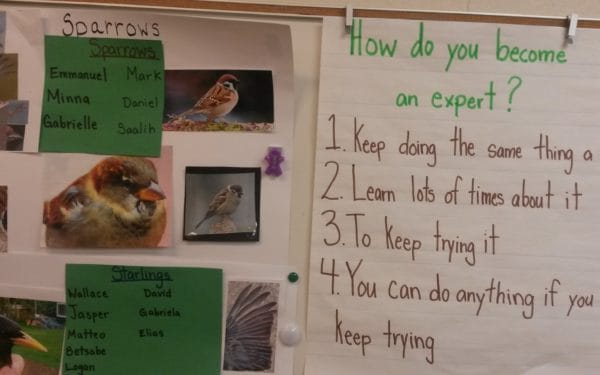January 28, 2015
(Photos: Jessica Hiltabidel/Center for Inspired Teaching)
Today’s post was written by Jessica Hiltabidel, Inspired Teaching’s Manager of Teaching & Learning. Jessica works with the Inspired Teacher Certification Program, which selects, trains, and supports exceptional new teachers for successful and sustainable careers in Washington, DC. Learn more about the Inspired Teacher Certification Program, and apply today.
Every teacher has had that moment. The one where you’re standing in front of your students, going through your lesson plan, asking questions, making connections, and encouraging participation. Then, a hand goes up and a question is asked. What follows is a moment of panic. You have no idea how the student thought of that question, let alone the answer. What do you do?
Many views of teaching place educators into the role of all-knowing information provider whose students are empty vessels that need filling. At Inspired Teaching, however, we believe that the role of the teacher is to be an Instigator of Thought, to facilitate the students’ ability to ask their own questions, seek their own answers, and become the experts themselves. For a teacher who’s an Instigator of Thought, a question without an easy answer provides an opportunity to build deeper student engagement and learning. This idea of “Student as Expert” is one of the 5 Core Elements Inspired Teaching believes are necessary to ensure all students successfully build the 4 I’s: Intellect, Inquiry, Imagination, and Integrity.
Recently, I was able to see a wonderful example of “Student as Expert” in the classroom of one of our 2013 Fellows. Ms. Renee Richardson is a kindergarten teacher at Capital City Public Charter School and is working with her students to complete an expedition, or a project-based instructional unit, on birds. I joined the class as morning meeting ended and was surprised by the strategy Ms. Richardson used to transition to the next lesson. Instead of calling student names, groups, or using traditional music, she played a clip of birds tweeting. Immediately, hands shot into the air as students were able to identify the unique sounds of the bird their group was studying. I don’t think I’d be able to differentiate between starlings, robins, and sparrows even if I could see them; and yet, here were five- and six-year-olds exuberantly recognizing and explaining to me how the robin has a short high-pitched “meep” while the sparrow uses a more buzzy sound.
From there, students broke up into groups to practice their observation skills by making a more detailed second draft drawing of their assigned bird. I sat with the Starling Group who told me all about the different colors a starling can have. They showed me how the feathers had hints of green and purple. We talked about their blue eggs, yellow beaks, and long legs. The highlight was when the students showed me the birds they had in the room as class pets!
If you ask Ms. Richardson, she’ll tell you she’s not an avid birder; however, through the study of birds, she has been able to foster her kindergarten students’ interest and enhance their abilities to compare and contrast, use descriptive and advanced language, categorize, and research.
When students move beyond surface recall and memorization to independent mastery of facts, the difference is clear, even to those not trained as teachers. A few days after my visit to Ms. Richardson’s classroom, I was speaking to another 2013 Fellow at Capital City, Ms. Jessie Papalia. Her third grade students have been working on writing speeches, and one of her students interviewed Ms. Richardson’s kindergarten class. The third grader describes her findings and “Student as Expert” in her own way:
“You might be thinking, kindergartners? Teaching a third grader like me? Well let me tell you a little something, these were not any old regular kindergartners that all they do is play. These were educationally smart kindergartners!”
The third grader’s piece made me hopeful, but it also reminded me of how much work remains. I’m proud to celebrate the classrooms of Inspired Teaching Fellows like Ms. Richardson, and Inspired Teaching strives for the day where classrooms full of “Students as Expert” are exactly what “old regular kindergartners” look like.
Become an Inspired Teaching Fellow and changemaker like Ms. Richardson, and join the movement to change the way children are educated.



